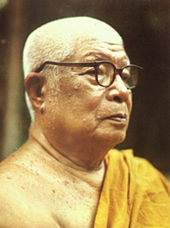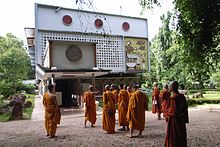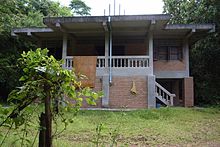Suan Mokkh
Suan Mokkh ( Thai สวน โมกข์ , "Garden of Liberation"), short for Suan Mokkhaphalaram ( Thai สวน โมกข พ ลา ราม from Pali Mokkhabalārāma , "Garden of the power of deliverance") is a Theravada - Buddhist monastery and retreat and meditation center in Amphoe Chaiya , Surat Thani Province , in southern Thailand . It was founded in 1932 by the well-known monk, religious and social reformer Buddhadasa Bhikkhu, who was a representative and thought leader of Engaged Buddhism .
The site has an area of almost 50 hectares and is largely covered with forest, which makes it stand out from the cleared, agriculturally used surrounding area.
history
Buddhadasa (actually Ngueam Phanit, 1906-1993), who at that time still bore the religious name Indapañño, returned in 1932 from his studies in Bangkok to his southern Thai homeland and moved into an abandoned monastery ( Wat ) near his birthplace Phumriang. He believed that a natural environment was conducive to the practice of Dhamma . In contrast to the existing monasteries of the Thai forest tradition , he did not want to emulate the teaching and meditation skills of a prominent monk, but only to follow the Dhamma and Vinaya of Gautama Buddha . He did not see study and practice as opposites, but as a complement. He sought to abolish the centuries-old differentiation of the Sangha between studying and ceremonial city monks and withdrawn, ascetic, meditating forest monks.
For the first four years, Buddhadasa lived mostly alone in Suan Mokkh, but also attended other wats to teach there. He also published his ideas and findings in the quarterly magazine Buddha-Sasana ("Buddhism") and gave lectures at the Buddha Dhamma Society in Bangkok. These were characterized by a simple language, without the typical monk's vocabulary, and an intellectual, demythologized interpretation of the Buddhist teachings. In doing so, he also drew the attention of established clergy and lay people in the capital. At the end of the 1930s, a small group of monks joined him, others - including high-ranking representatives of the Buddhist hierarchy and state officials - visited him in Suan Mokkh.
In the early 1940s, the original Suan Mokkh was so overcrowded that it had to be moved to another location. In 1942 Suan Mokkh II was founded in the former Wat Than Nam Lai ("Temple of flowing water"), over whose area a small river runs and on which the remains of a very old stupa were found. Two years later, the community moved there for good.
Suan Mokkh drew and attracts followers and interested parties of the Buddhadasa's philosophy from all social classes, at home and abroad. In 1972 Tenzin Gyatso , the 14th Dalai Lama of Tibetan Vajrayana Buddhism, visited Suan Mokkh to teach here. In 1989 the facility was significantly expanded and an international meditation center was created. A center for nuns was also set up. Buddhadasa died in Suan Mokkh in 1993.
investment
Suan Mokkh consists of several parts: the original main monastery and the later added International Dharma Heritage for lay people from all over the world. The part for Mae Chis (white-clad women who have dedicated their lives to religion but are not officially recognized as nuns in Thailand) is spatially separated from the other parts. The main buildings of the monastery, which are used for teaching the Dhamma, are concrete structures shaped like boats and are therefore also called "ships of the Dharma". Another central facility is the "Spiritual Theater", in which the teaching content of Buddhism is presented in pictures. There are murals and sculptures in very different styles (Thai, Egyptian, Chinese, Indian, Japanese, Tibetan and European).
The central meditation hall ( sala ) is open on the sides, its floor is covered with sand. This corresponds to the ideal of the most natural environment possible for Buddhadasa. The kutis (cells of the monks) are scattered along forest paths across the area. The laymen's accommodations are just as spartan: they only have beds made of cement with a mat and wooden "pillows". There are shared water points on the site for washing clothes or body cleaning, as well as hot springs for foot baths.
Suan Mokkh differs significantly from ordinary wats (Buddhist temple-monasteries) in Thailand. There is no large statue of Buddha and no religious ceremonies are held. The appearance of this retreat is therefore relatively secular.
Meditation program
An organized retreat at Suan Mokkh lasts 10 days and starts on the first day of each month. The Ānāpānasati meditation (“mindfulness of breathing in and out”) is taught. Participants go barefoot, eat only one modest vegetarian meal a day, sleep on a wooden pillow, and get up at 4 a.m. During the entire time you should be silent, not read, write, smoke, drink alcohol or think about sexual matters. The basic principle of Ānāpānasati is to breathe in consciously, to feel the breath in the body, to breathe out consciously and not to think about anything else. The daily routine includes meditation while sitting and walking, yoga , lectures on the Dhamma and reciting Buddhist chants, but also doing the household chores of the monastery. During all activities, including cleaning the courtyard, washing dishes or cleaning the toilets, the participants should continue to pay attention to their breathing.
Individual evidence
- ↑ Leslie Sponsel, Poranee Natadecha-Sponsel: Buddhist Views of Nature and the Environment. In: Nature Across Cultures. Views of Nature and the Environment in Non-Western Cultures. Kluwer, Dordrecht / Norwell MA 2003, pp. 351–372, on p. 360.
- ↑ Santikaro Bhikkhu: Buddhadasa Bhikkhu. Life and Society through the Natural Eyes of Voidness. In: Engaged Buddhism. Buddhist Liberation Movements in Asia. State University of New York Press, Albany 1996, pp. 147-193, at p. 152.
- ↑ Santikaro: Buddhadasa Bhikkhu. 1996, p. 153.
- ↑ Santikaro: Buddhadasa Bhikkhu. 1996, p. 154.
- ↑ Kamala Tiyavanich: Sons of the Buddha. The Early Lives of Three Extraordinary Thai Masters. Wisdom Publications, Somerville MA 2007, p. 1.
- ↑ Monika and Udo Tworuschka: The world of religions. Chronik Verlag, Gütersloh / Munich 2006, p. 56.
- ^ A b Charles Agar: Frommer's Thailand. 7th edition, Wiley, Hoboken NJ 2006, p. 196.
- ↑ Ron Emmons: Frommer's Thailand. 10th edition, Wiley, Chichester (West Sussex) 2012, p. 174.
- ↑ a b Brooke Schedneck: Constructing Religious Modernities. Hybridity, Reinterpretation, and Adaptation in Thailand's International Meditation Centers. ( Memento of the original from July 7th, 2015 in the Internet Archive ) Info: The archive link was inserted automatically and has not yet been checked. Please check the original and archive link according to the instructions and then remove this notice. Dissertation, Arizona State University, 2012, p. 247.
- ↑ Schedneck: Constructing Religious Modernities. 2012, p. 246.
- ↑ Schedneck: Constructing Religious Modernities. 2012, p. 245.
- ^ Colin Hinshelwood takes a silent challenge in Surat Thani. In Nabanita Dutt (Ed.): To Thailand With Love. ThingsAsian Press, San Francisco 2013, pp. 120-121.
Web links
Coordinates: 9 ° 21 ′ 37 ″ N , 99 ° 10 ′ 6 ″ E




